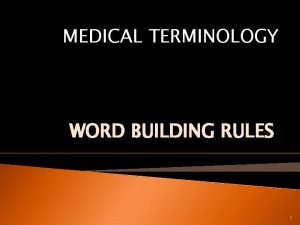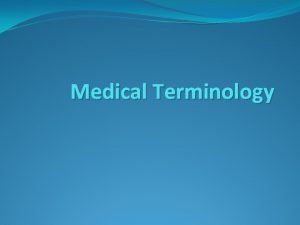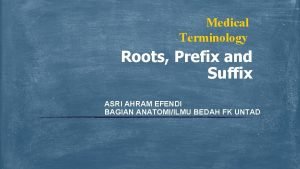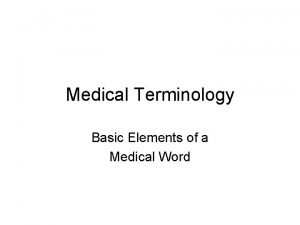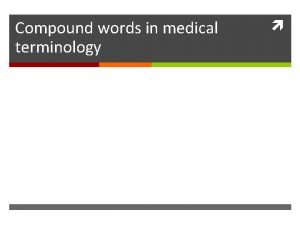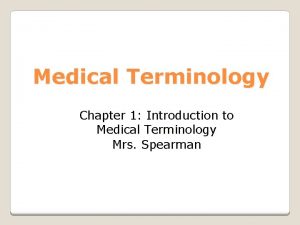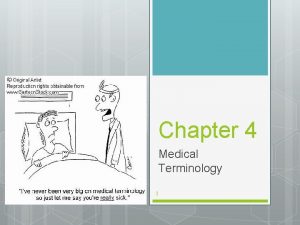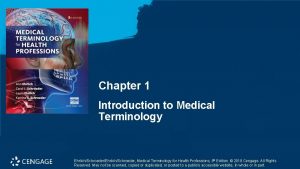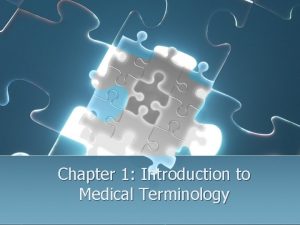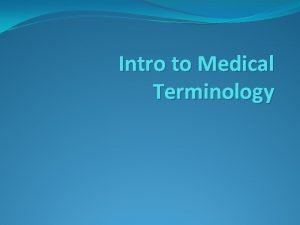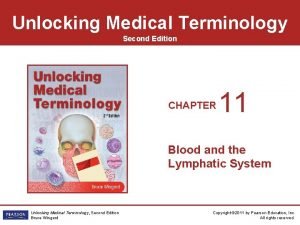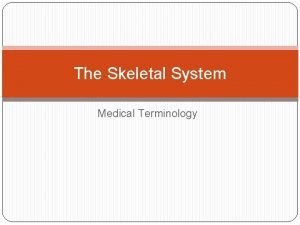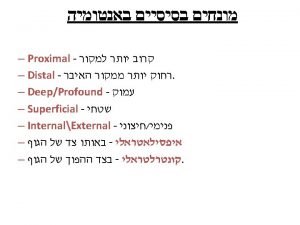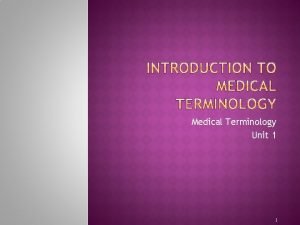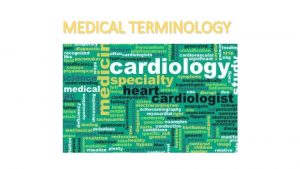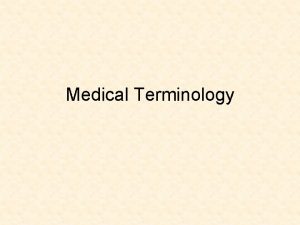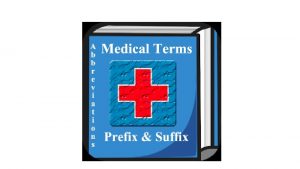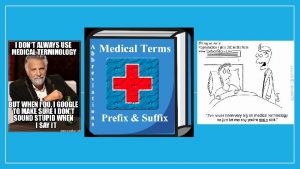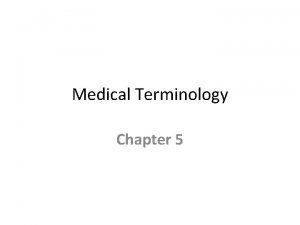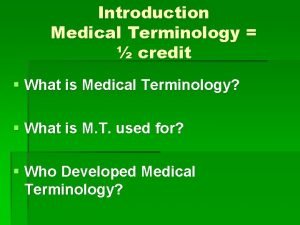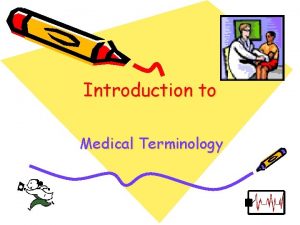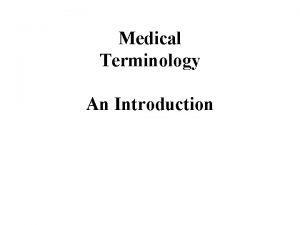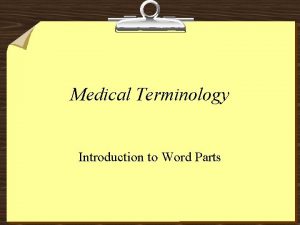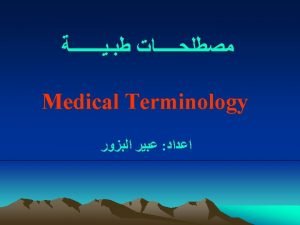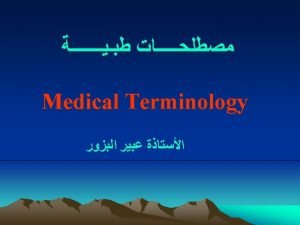Intro to Medical Terminology Introduction to Word Parts























- Slides: 23

Intro to Medical Terminology

Introduction to Word Parts �Objectives: �Identify and define the four word parts. �Identify and define a combining form. �Analyze and define medical terms. �Build medical terms for given definitions.

Origins of Medical Language �Medicine has a language of its own. Medical language, like the language of a people, also has a historic development. �Current medical vocabulary includes terms built from Greek and Latin word parts, some of which were used by Hippocrates and Aristotle more than 2400 years ago. Some terms are eponyms, some are acronyms, and some terms are from modern medical language.

�Eponym is a word based on the name of a person, such as Parkinson disease. �Parkinson disease is named after James Parkinson, English physician who first described the disease in 1817 as shaking palsy. �Parkinson disease a common neurologic disease believed to be caused by deterioration of the brain cells that produce dopamine, occurring primarily after the age of 60, characterized by tremors, especially of the fingers and hands, muscle rigidity, shuffling gait, slow speech, and a masklike facial expression.

�Acronym is a word formed from the first letters of the words in a set phrase, such as SARS (Severe Acute Respiratory Syndrome) or LASER (Light Amplification by Stimulated Emission of Radiation) �An example of a Greek medical term is hemorrhage (hemo- meaning blood and –rrhage meaning excessive flow; i. e. hemorrhage is excessive flow of blood) �An example of a Latin medical term is Femur or Femoris is Latin for thigh bone. �Nuclear medicine scanner is an example of Modern Medical Language.

�With the advancement of medical and scientific knowledge, medical language changes. Some words are discarded, the meanings of others are altered, and new words are added. �The majority of medical terms in current use are composed of Greek and Latin word parts. �These terms can be learned by two ways: � 1. Memorizing medical terms. (Monotonous) � 2. Learning word parts and how they fit together to form medical terms. (Easier)

�Learning word parts and how they fit together provides the key to learning scores of medical terms. �Therefore the word part method is used to learn terms composed of word parts. �The memorization method is used to learn other terms not built from word parts, such as Alzheimer disease or coronary artery bypass graft.

The Four Word Parts �Most medical terms built from word parts consist of some or all of the following components: � 1. WORD ROOTS � 2. SUFFIXES � 3. PREFIXES � 4. COMBINING VOWELS

Word Root �The word root is the word part that is the core of the word. �The word root contains the fundamental meaning of the word �Since the word root is the core of the word, each medical term contains one or more word roots.

Examples of Word Roots �Play/er; In this word, play is the word root. �Arthr/itis; In this medical term, arthr (which means joint) is the word root. �Hepat/itis; In this medical term, hepat (which means liver) is the word root. �Complete the following: A word root is…

Suffix �The suffix is a word part attached to the end of the word root to modify its meaning. �The suffix frequently indicates a procedure, condition, or disease such as �–scopy, meaning visual examination (procedure) �–tomy, meaning surgical incision (procedure) �-itis, meaning inflammation (condition) �-oma, meaning tumor (disease)

Suffix Examples �The suffix is used to modify the meaning of a word. Most medical terms have a suffix. �Play/er in this word, -er is the suffix. �Hepat/ic in this medical term, -ic (which means pertaining to) is the suffix. �Hepat is the word root for liver; therefore hepatic means pertaining to the liver. �Hepat/itis in this medical term, -itis (which means inflammation) is the suffix. �The term hepatitis means. . . �Complete the following: The suffix is…

Prefix �The prefix is a word part attached to the beginning of a word root to modify its meaning. �Although a prefix can be used to modify the meaning of a word, many medical terms do not have a prefix. �Prefixes can indicate; �A number such as bi-, meaning two. �A position, such as sub-, meaning under. �A direction, such as intra-, meaning within. �Time, such as brady-, meaning slow �Negation, such as a-, meaning without

Prefix Examples �Re/play In this word, re- is the prefix. �Sub/hepat/ic In this medical term, sub- (which means under) is the prefix. �What does the term Subhepatic mean? �Subhepatic means pertaining to under the liver. �Intra/ven/ous In this word, intra- (which means within) is the prefix. �Identify the word root in the medical term Intravenous. �The word root is _____, which means vein.

�What is the suffix in the word intravenous? �The suffix is ____, which means pertaining to. �So what does the word intravenous mean? �Intravenous means ___________. �Complete the following; The prefix is…

Combining Vowel �The combining vowel is a word part, usually an o, used to ease pronunciation. �The combining vowel is: �Used to connect two word roots. �Used to connect a word root and a suffix. �Not used to connect a prefix and a word root.

Examples of Combining Vowels �In the word men/o/pause �O is the combining vowel used between two word roots �In the medical term arthr/o/pathy �O is the combining vowel used between the word root arthr and the suffix –pathy (which means disease). �In the medical term sub/hepat/ic �The combining vowel is not used between the prefix sub- and the word root hepat.

Guidelines for Using Combining Vowels �Guideline #1: When connecting a word root and a suffix, a combining vowel IS USED if the suffix DOES NOT begin with a vowel. �Guideline #1 Example �In the medical term arthr/o/pathy the suffix –pathy does not begin with a vowel; therefore a combining vowel is used.

�Guideline #2: When connecting a word root and a suffix, a combining vowel is USUALLY NOT USED if the suffix DOES BEGIN with a vowel. �Guideline #2 Example: �In the medical term hepat/ic, the suffix -ic begins with the vowel i; therefore a combining vowel is not used.

�Guideline #3: When connecting two word roots, a combining vowel is usually used even if vowels are present at the junction. �Guideline #3 Example: �In the medical term oste/o/arthr/itis o is the combining vowel used, even though the word root oste (which means bone) ends with the vowel e, and the word root arthr begins with the vowel a.

�Guideline #4: When connecting a prefix and a word root, a combining vowel is not used. �Guideline #4 Example: �In the medical term sub/hepat/ic, the combining vowel is not used between the prefix sub- and the word root hepat. *The combining vowel is used to ease pronunciation; therefore not all medical terms have combing vowels.

Combining Form �A combining form is a word root with the combining vowel attached, separated by a vertical slash. �Examples �arthr/o �oste/o �ven/o �The combining form is not a word part per se; rather it is the word root and the combining vowel.

Summary �Word root- core of a word; for example, hepat �Suffix- attached at the end of a word root to modify its meaning; for example, -ic. �Prefix- attached at the beginning of a word to modify its meaning; for example, Sub�Combining Vowel- usually an o used between two word roots or a word root and a suffix to ease pronunciation; for example hepat o pathy �Combining form- word root plus combining vowel separated by a vertical slash; for example, hepat/o.
 Erythrocytopenia prefix
Erythrocytopenia prefix Ocele medical term
Ocele medical term Did terms
Did terms Gastroenteritis suffix
Gastroenteritis suffix Word elements medical terminology
Word elements medical terminology Prefix latin
Prefix latin Compound word in medical terminology
Compound word in medical terminology Learning exercises chapter 1 medical terminology
Learning exercises chapter 1 medical terminology Apathy word surgery
Apathy word surgery Medical short hand
Medical short hand Chapter 1 introduction to medical terminology
Chapter 1 introduction to medical terminology Chapter 1 introduction to medical terminology
Chapter 1 introduction to medical terminology The word part attached to the beginning of a word is the
The word part attached to the beginning of a word is the Chapter 11 medical terminology
Chapter 11 medical terminology Medical terminology skeletal system
Medical terminology skeletal system Anatomical position body erect
Anatomical position body erect Synonymy
Synonymy Lesson 12 medical terminology
Lesson 12 medical terminology Medical terminology notes
Medical terminology notes Dextro medical term
Dextro medical term Khan cademy
Khan cademy Lacrim/o combining form
Lacrim/o combining form Esis medical term examples
Esis medical term examples Urethrostenosis medical term
Urethrostenosis medical term

